A Multi-Spectroscopic and Molecular Docking Analysis of the Biophysical Interaction between Food Polyphenols, Urolithins, and Human Serum Albumin
Abstract
:1. Introduction
2. Results and Discussion
2.1. Urolithins Quenching the Intrinsic Fluorescence of HSA
2.2. Stern–Volmer Plots and Constants
2.3. Binding Constants and Number of Binding Sites
2.4. Thermodynamic Parameter and Interaction Modes
2.5. Synchronous Fluorescence Spectra of URO–HSA System
2.6. FT-IR Spectroscopy
2.7. Circular Dichroism (CD) Spectroscopy
2.8. Molecular Docking Studies
3. Materials and Methods
3.1. Materials
3.2. Methods
3.2.1. Measurement of Fluorescence Quenching of HSA
3.2.2. Stern–Volmer (SV) and Modified Stern–Volmer Equation
3.2.3. Thermodynamic Parameters of URO–HSA Complexes
3.2.4. Measurement of Synchronous Fluorescence Spectrum
3.2.5. Fourier Transform Infrared Spectroscopy (FTIR)
3.2.6. Circular Dichroism (CD) Analysis
3.2.7. Molecular Docking
3.2.8. Statistical Analysis
4. Conclusions
Supplementary Materials
Author Contributions
Funding
Institutional Review Board Statement
Informed Consent Statement
Data Availability Statement
Conflicts of Interest
References
- Tomás-Barberán, F.A.; González-Sarrías, A.; García-Villalba, R.; Núñez-Sánchez, M.A.; Selma, M.V.; García-Conesa, M.T.; Espín, J.C. Urolithins, the rescue of “old” metabolites to understand a “new” concept: Metabotypes as a nexus among phenolic metabolism, microbiota dysbiosis, and host health status. Mol. Nutr. Food Res. 2017, 61, 1500901. [Google Scholar] [CrossRef] [PubMed]
- Cerdá, B.; Tomás-Barberán, F.A.; Espín, J.C. Metabolism of antioxidant and chemopreventive ellagitannins from strawberries, raspberries, walnuts, and oak-aged wine in humans: Identification of biomarkers and individual variability. J. Agric. Food Chem. 2005, 53, 227–235. [Google Scholar] [CrossRef] [PubMed]
- García-Villalba, R.; Giménez-Bastida, J.A.; Cortés-Martín, A.; Ávila-Gálvez, M.Á.; Tomás-Barberán, F.A.; Selma, M.V.; Espín, J.C.; González-Sarrías, A. Urolithins: A comprehensive update on their metabolism, bioactivity, and associated gut microbiota. Mol. Nutr. Food Res. 2022, 66, 2101019. [Google Scholar] [CrossRef]
- Espín, J.C.; Larrosa, M.; García-Conesa, M.T.; Tomás-Barberán, F. Biological significance of urolithins, the gut microbial ellagic acid-derived metabolites: The evidence so far. Evid.-Based Complement. Altern. Med. 2013, 2013, 270418. [Google Scholar] [CrossRef] [PubMed]
- Ávila-Gálvez, M.; Espín, J.C.; González-Sarrías, A. Physiological relevance of the antiproliferative and estrogenic effects of dietary polyphenol aglycones versus their phase-II metabolites on breast cancer cells: A call of caution. J. Agric. Food Chem. 2018, 66, 8547–8555. [Google Scholar] [CrossRef] [PubMed]
- Zhang, S.; Al-Maghout, T.; Salker, M.S.; Veldhoen, M.; Cheng, A.; Lang, F.; Singh, Y. Gut bacterial metabolite Urolithin A (UA) mitigates Ca2+ entry in T cells by regulating miR-10a-5p. Front. Immunol. 2019, 10, 460856. [Google Scholar] [CrossRef]
- Ávila-Gálvez, M.; Giménez-Bastida, J.; González-Sarrías, A.; Espín, J. Tissue deconjugation of urolithin A glucuronide to free urolithin A in systemic inflammation. Food Funct. 2019, 10, 3135–3141. [Google Scholar] [CrossRef]
- D’Amico, D.; Andreux, P.A.; Valdés, P.; Singh, A.; Rinsch, C.; Auwerx, J. Impact of the natural compound urolithin A on health, disease, and aging. Trends Mol. Med. 2021, 27, 687–699. [Google Scholar] [CrossRef]
- Singh, A.; D’Amico, D.; Andreux, P.A.; Dunngalvin, G.; Kern, T.; Blanco-Bose, W.; Auwerx, J.; Aebischer, P.; Rinsch, C. Direct supplementation with Urolithin A overcomes limitations of dietary exposure and gut microbiome variability in healthy adults to achieve consistent levels across the population. Eur. J. Clin. Nutr. 2022, 76, 297–308. [Google Scholar] [CrossRef]
- Singh, A.; D’Amico, D.; Andreux, P.A.; Fouassier, A.M.; Blanco-Bose, W.; Evans, M.; Aebischer, P.; Auwerx, J.; Rinsch, C. Urolithin A improves muscle strength, exercise performance, and biomarkers of mitochondrial health in a randomized trial in middle-aged adults. Cell Rep. Med. 2022, 3, 100633. [Google Scholar] [CrossRef]
- Carvalho, J.R.; Machado, M.V. New insights about albumin and liver disease. Ann. Hepatol. 2018, 17, 547–560. [Google Scholar] [CrossRef] [PubMed]
- Ward, E.S.; Gelinas, D.; Dreesen, E.; Van Santbergen, J.; Andersen, J.T.; Silvestri, N.J.; Kiss, J.E.; Sleep, D.; Rader, D.J.; Kastelein, J.J. Clinical significance of serum albumin and implications of FcRn inhibitor treatment in IgG-mediated autoimmune disorders. Front. Immunol. 2022, 13, 892534. [Google Scholar] [CrossRef]
- Lee, P.; Wu, X. Modifications of human serum albumin and their binding effect. Curr. Pharm. Des. 2015, 21, 1862–1865. [Google Scholar] [CrossRef] [PubMed]
- Zelenovic, N.; Kojadinovic, M.; Filipovic, L.; Vucic, V.; Milcic, M.; Arsic, A.; Popovic, M. Interactions of Different Urolithins With Bovine Serum Albumin. Nat. Prod. Commun. 2023, 18, 1934578X231169366. [Google Scholar] [CrossRef]
- Wang, J.; Ma, L.; Zhang, Y.; Jiang, T. Investigation of the interaction of deltamethrin (DM) with human serum albumin by multi-spectroscopic method. J. Mol. Struct. 2017, 1129, 160–168. [Google Scholar] [CrossRef]
- He, J.; Wang, Q.; Zhang, L.; Lin, X.; Li, H. Docking simulations and spectroscopy of the interactions of ellagic acid and oleuropein with human serum albumin. J. Lumin. 2014, 154, 578–583. [Google Scholar] [CrossRef]
- Lakowicz, J.R. (Ed.) Quenching of Fluorescence. In Principles of Fluorescence Spectroscopy; Springer: Boston, MA, USA, 2006; pp. 277–330. [Google Scholar] [CrossRef]
- Punith, R.; Seetharamappa, J. Spectral characterization of the binding and conformational changes of serum albumins upon interaction with an anticancer drug, anastrozole. Spectrochim. Acta Part A Mol. Biomol. Spectrosc. 2012, 92, 37–41. [Google Scholar] [CrossRef] [PubMed]
- Hashempour, S.; Shahabadi, N.; Adewoye, A.; Murphy, B.; Rouse, C.; Salvatore, B.A.; Stratton, C.; Mahdavian, E.J.M. Binding studies of AICAR and human serum albumin by spectroscopic, theoretical, and computational methodologies. Molecules 2020, 25, 5410. [Google Scholar] [CrossRef] [PubMed]
- Roufegarinejad, L.; Jahanban-Esfahlan, A.; Sajed-Amin, S.; Panahi-Azar, V.; Tabibiazar, M. Molecular interactions of thymol with bovine serum albumin: Spectroscopic and molecular docking studies. J. Mol. Recognit. 2018, 31, e2704. [Google Scholar] [CrossRef]
- Ross, P.D.; Subramanian, S. Thermodynamics of protein association reactions: Forces contributing to stability. Biochemistry 1981, 20, 3096–3102. [Google Scholar] [CrossRef]
- Cooper, A. Thermodynamic analysis of biomolecular interactions. Curr. Opin. Chem. Biol. 1999, 3, 557–563. [Google Scholar] [CrossRef] [PubMed]
- Dockal, M.; Carter, D.C.; Ruker, F. The three recombinant domains of human serum albumin: Structural characterization and ligand binding properties. J. Biol. Chem. 1999, 274, 29303–29310. [Google Scholar] [CrossRef] [PubMed]
- Trynda-Lemiesz, L. Paclitaxel–HSA interaction. Binding sites on HSA molecule. Bioorganic Med. Chem. 2004, 12, 3269–3275. [Google Scholar] [CrossRef]
- Liu, Y.; Xie, M.-X.; Kang, J.; Zheng, D. Studies on the interaction of total saponins of panax notoginseng and human serum albumin by Fourier transform infrared spectroscopy. Spectrochim. Acta Part A Mol. Biomol. Spectrosc. 2003, 59, 2747–2758. [Google Scholar] [CrossRef] [PubMed]
- Purcell, M.; Neault, J.; Malonga, H.; Arakawa, H.; Carpentier, R.; Tajmir-Riahi, H. Interactions of atrazine and 2, 4-D with human serum albumin studied by gel and capillary electrophoresis, and FTIR spectroscopy. Biochim. Biophys. Acta-Protein Struct. Mol. Enzymol. 2001, 1548, 129–138. [Google Scholar] [CrossRef]
- Milošević, J.; Prodanović, R.; Polović, N. On the protein fibrillation pathway: Oligomer intermediates detection using ATR-FTIR spectroscopy. Molecules 2021, 26, 970. [Google Scholar] [CrossRef]
- Qin, C.; Xie, M.-X.; Liu, Y. Characterization of the myricetin−human serum albumin complex by spectroscopic and molecular modeling approaches. Biomacromolecules 2007, 8, 2182–2189. [Google Scholar] [CrossRef]
- Kelly, S.M.; Jess, T.J.; Price, N.C. How to study proteins by circular dichroism. Biochim. Biophys. Acta (BBA)-Proteins Proteom. 2005, 1751, 119–139. [Google Scholar] [CrossRef]
- Greenfield, N.J. Using circular dichroism spectra to estimate protein secondary structure. Nat. Protoc. 2006, 1, 2876–2890. [Google Scholar] [CrossRef]
- Wang, Y.-Q.; Tang, B.-P.; Zhang, H.-M.; Zhou, Q.-H.; Zhang, G.-C. Studies on the interaction between imidacloprid and human serum albumin: Spectroscopic approach. J. Photochem. Photobiol. B Biol. 2009, 94, 183–190. [Google Scholar] [CrossRef]
- Fanali, G.; Di Masi, A.; Trezza, V.; Marino, M.; Fasano, M.; Ascenzi, P. Human serum albumin: From bench to bedside. Mol. Asp. Med. 2012, 33, 209–290. [Google Scholar]
- Laskowski, R.A.; Swindells, M.B. LigPlot+: Multiple ligand–protein interaction diagrams for drug discovery. J. Chem. Inf. Model. 2011, 51, 2778–2786. [Google Scholar] [CrossRef]
- González-Sarrías, A.; Miguel, V.N.; Merino, G.; Lucas, R.; Morales, J.C.; Tomás-Barberán, F.; Álvarez, A.I.; Espín, J.C. The gut microbiota ellagic acid-derived metabolite urolithin A and its sulfate conjugate are substrates for the drug efflux transporter breast cancer resistance protein (ABCG2/BCRP). J. Agric. Food Chem. 2013, 61, 4352–4359. [Google Scholar] [CrossRef] [PubMed]
- Bialonska, D.; Kasimsetty, S.G.; Khan, S.I.; Ferreira, D. Urolithins, intestinal microbial metabolites of pomegranate ellagitannins, exhibit potent antioxidant activity in a cell-based assay. J. Agric. Food Chem. 2009, 57, 10181–10186. [Google Scholar] [CrossRef] [PubMed]
- Lucas, R.; Alcantara, D.; Morales, J.C. A concise synthesis of glucuronide metabolites of urolithin-B, resveratrol, and hydroxytyrosol. Carbohydr. Res. 2009, 344, 1340–1346. [Google Scholar] [CrossRef]
- Birdsall, B.; King, R.W.; Wheeler, M.R.; Lewis, C.A., Jr.; Goode, S.R.; Dunlap, R.B.; Roberts, G.C. Correction for light absorption in fluorescence studies of protein-ligand interactions. Anal. Biochem. 1983, 132, 353–361. [Google Scholar] [CrossRef]
- Marković, O.S.; Cvijetić, I.N.; Zlatović, M.V.; Opsenica, I.M.; Konstantinović, J.M.; Jovanović, N.V.T.; Šolaja, B.A.; Verbić, T.Ž. Human serum albumin binding of certain antimalarials. Spectrochim. Acta Part A Mol. Biomol. Spectrosc. 2018, 192, 128–139. [Google Scholar] [CrossRef]
- Seedher, N.; Bhatia, S. Reversible binding of celecoxib and valdecoxib with human serum albumin using fluorescence spectroscopic technique. Pharmacol. Res. 2006, 54, 77–84. [Google Scholar] [CrossRef]
- Peng, M.; Wang, Y.; Wu, C.; Cai, X.; Wu, Y.; Du, E.; Zheng, L.; Fu, J. Investigating sulfonamides-Human serum albumin interactions: A comprehensive approach using multi-spectroscopy, DFT calculations, and molecular docking. Biophys. Res. Commun. 2023, 683, 149108. [Google Scholar] [CrossRef]
- Lima, S.A.; Cordeiro-da-Silva, A.; de Castro, B.; Gameiro, P. Sensitivity of P-glycoprotein tryptophan residues to benzodiazepines and ATP interaction. Biophys. Chem. 2007, 125, 143–150. [Google Scholar] [CrossRef]
- Rashtbari, S.; Dehghan, G.; Sadeghi, L.; Sareminia, L.; Iranshahy, M.; Iranshahi, M.; Khataee, A.; Yoon, Y. Interaction of bovine serum albumin with ellagic acid and urolithins A and B: Insights from surface plasmon resonance, fluorescence, and molecular docking techniques. Food Chem. Toxicol. 2022, 162, 112913. [Google Scholar] [CrossRef] [PubMed]
- Sugio, S.; Kashima, A.; Mochizuki, S.; Noda, M.; Kobayashi, K. Crystal structure of human serum albumin at 2.5 Å resolution. Protein Eng. 1999, 12, 439–446. [Google Scholar] [CrossRef] [PubMed]
- Pomyalov, S.; Minetti, C.A.; Remeta, D.P.; Bonala, R.; Johnson, F.; Zaitseva, I.; Iden, C.; Golebiewska, U.; Breslauer, K.J.; Shoham, G. Structural and mechanistic insights into the transport of aristolochic acids and their active metabolites by human serum albumin. J. Biol. Chem. 2024, 300, 107358. [Google Scholar] [CrossRef] [PubMed]
- Wardell, M.; Wang, Z.; Ho, J.X.; Robert, J.; Ruker, F.; Ruble, J.; Carter, D.C. The atomic structure of human methemalbumin at 1.9 Å. Biochem. Biophys. Res. Commun. 2002, 291, 813–819. [Google Scholar] [CrossRef] [PubMed]
- Berman, H.; Henrick, K.; Nakamura, H. Announcing the worldwide protein data bank. Nat. Struct. Mol. Biol. 2003, 10, 980. [Google Scholar] [CrossRef]
- Allinger, N.L. Conformational analysis. 130. MM2. A hydrocarbon force field utilizing V1 and V2 torsional terms. J. Am. Chem. Soc. 1977, 99, 8127–8134. [Google Scholar] [CrossRef]
- Verdonk, M.L.; Cole, J.C.; Hartshorn, M.J.; Murray, C.W.; Taylor, R.D. Improved protein–ligand docking using GOLD. Proteins Struct. Funct. Bioinform. 2003, 52, 609–623. [Google Scholar] [CrossRef]
- Jones, G.; Willett, P.; Glen, R.C.J.J.o.m.b. Molecular recognition of receptor sites using a genetic algorithm with a description of desolvation. J. Mol. Biol. 1995, 245, 43–53. [Google Scholar] [CrossRef]
- Nissink, J.W.M.; Murray, C.; Hartshorn, M.; Verdonk, M.L.; Cole, J.C.; Taylor, R. A new test set for validating predictions of protein–ligand interaction. Proteins Struct. Funct. Bioinform. 2002, 49, 457–471. [Google Scholar] [CrossRef]
- Hartshorn, M.J.; Verdonk, M.L.; Chessari, G.; Brewerton, S.C.; Mooij, W.T.; Mortenson, P.N.; Murray, C.W. Diverse, high-quality test set for the validation of protein− ligand docking performance. J. Med. Chem. 2007, 50, 726–741. [Google Scholar] [CrossRef]
- Chen, P.; Guo, Z.; Chen, F.; Wu, Y.; Zhou, B. Recent Advances and Perspectives on the Health Benefits of Urolithin B, A Bioactive Natural Product Derived From Ellagitannins. Front. Pharmacol. 2022, 13, 917266. [Google Scholar] [CrossRef] [PubMed]
- Harper, P. A Review of the Dietary Intake, Bioavailability and Health Benefits of Ellagic Acid (EA) with a Primary Focus on Its Anti-Cancer Properties. Cureus 2023, 15, e43156. [Google Scholar] [CrossRef] [PubMed]
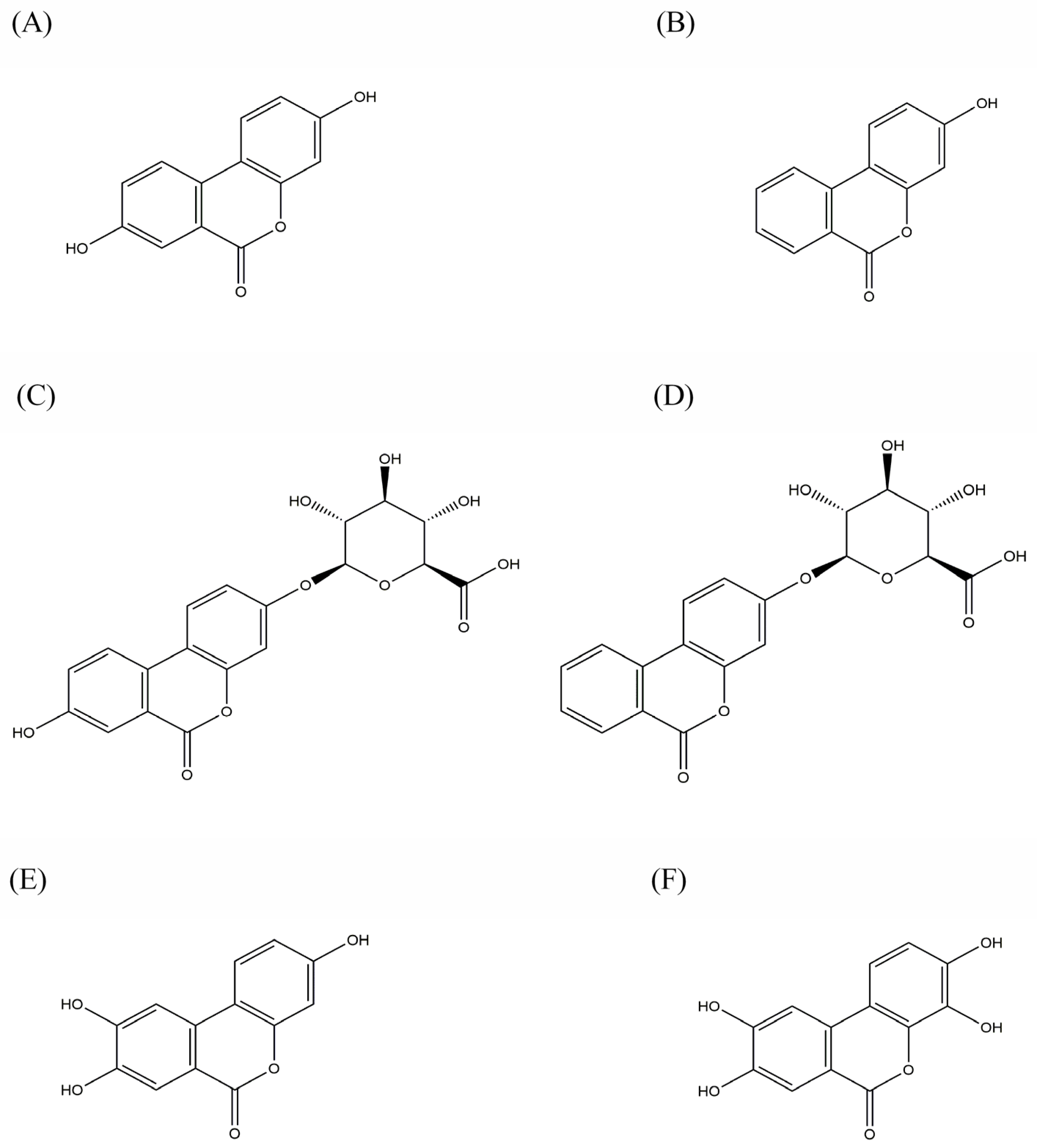
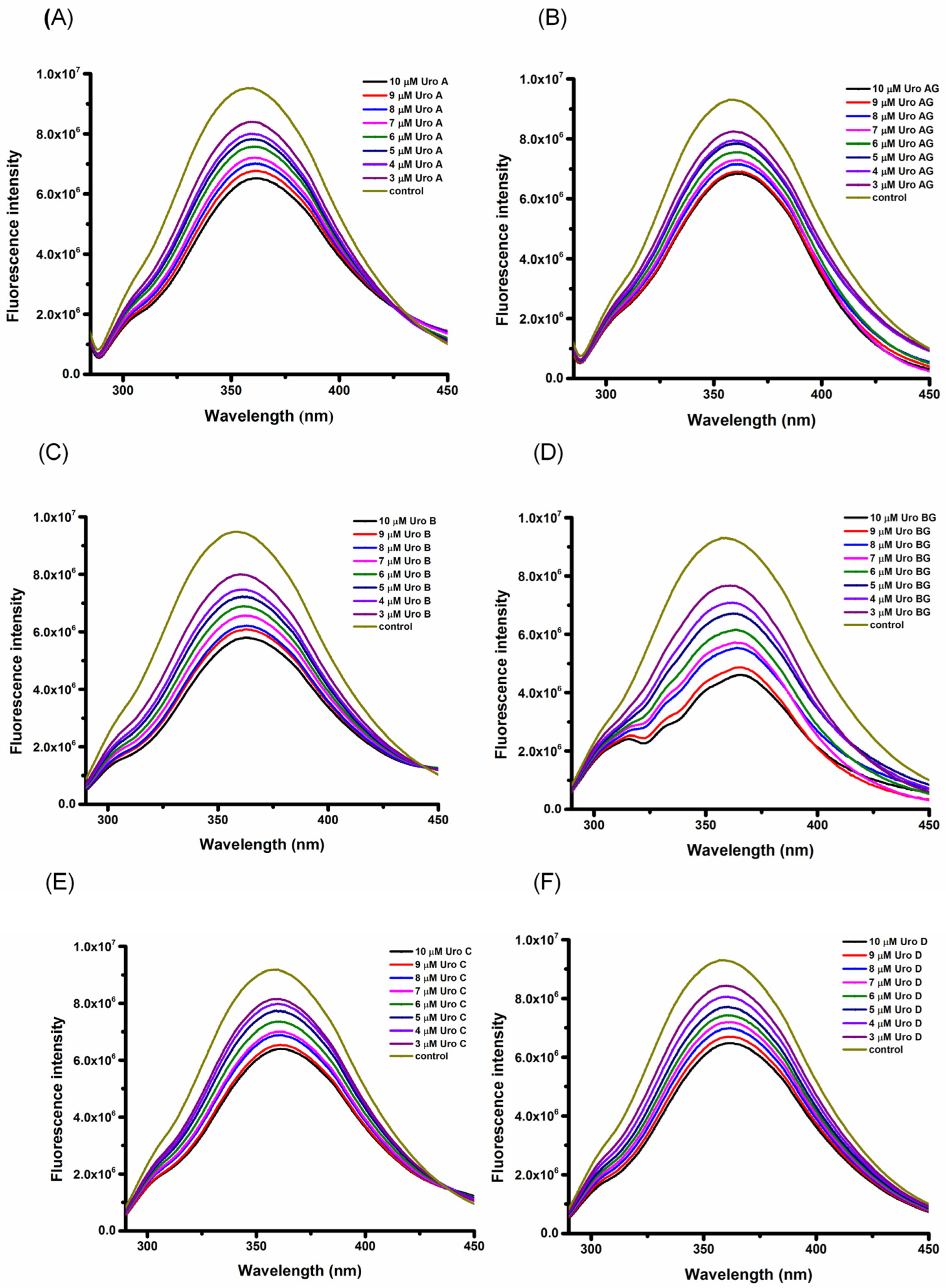

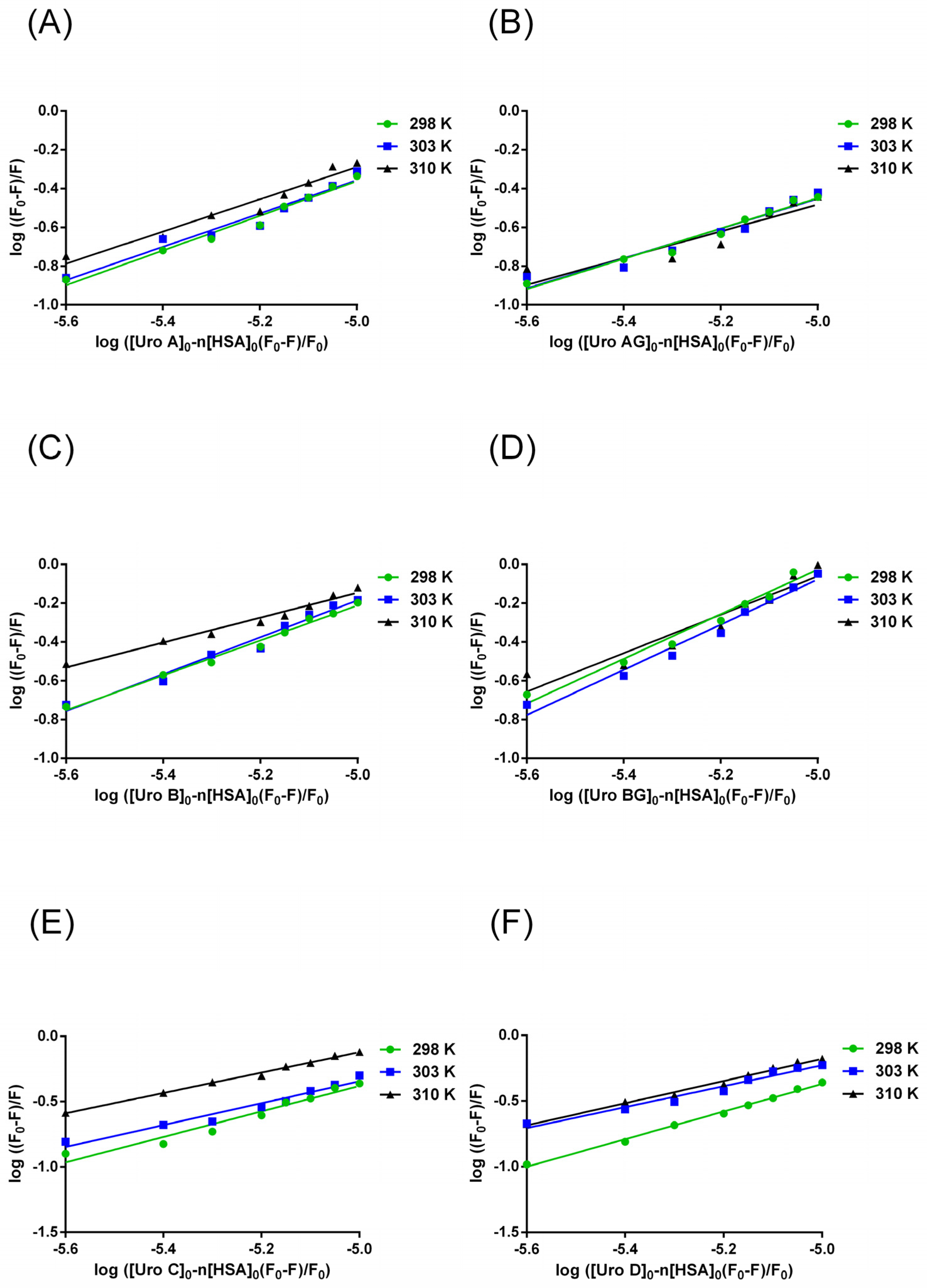
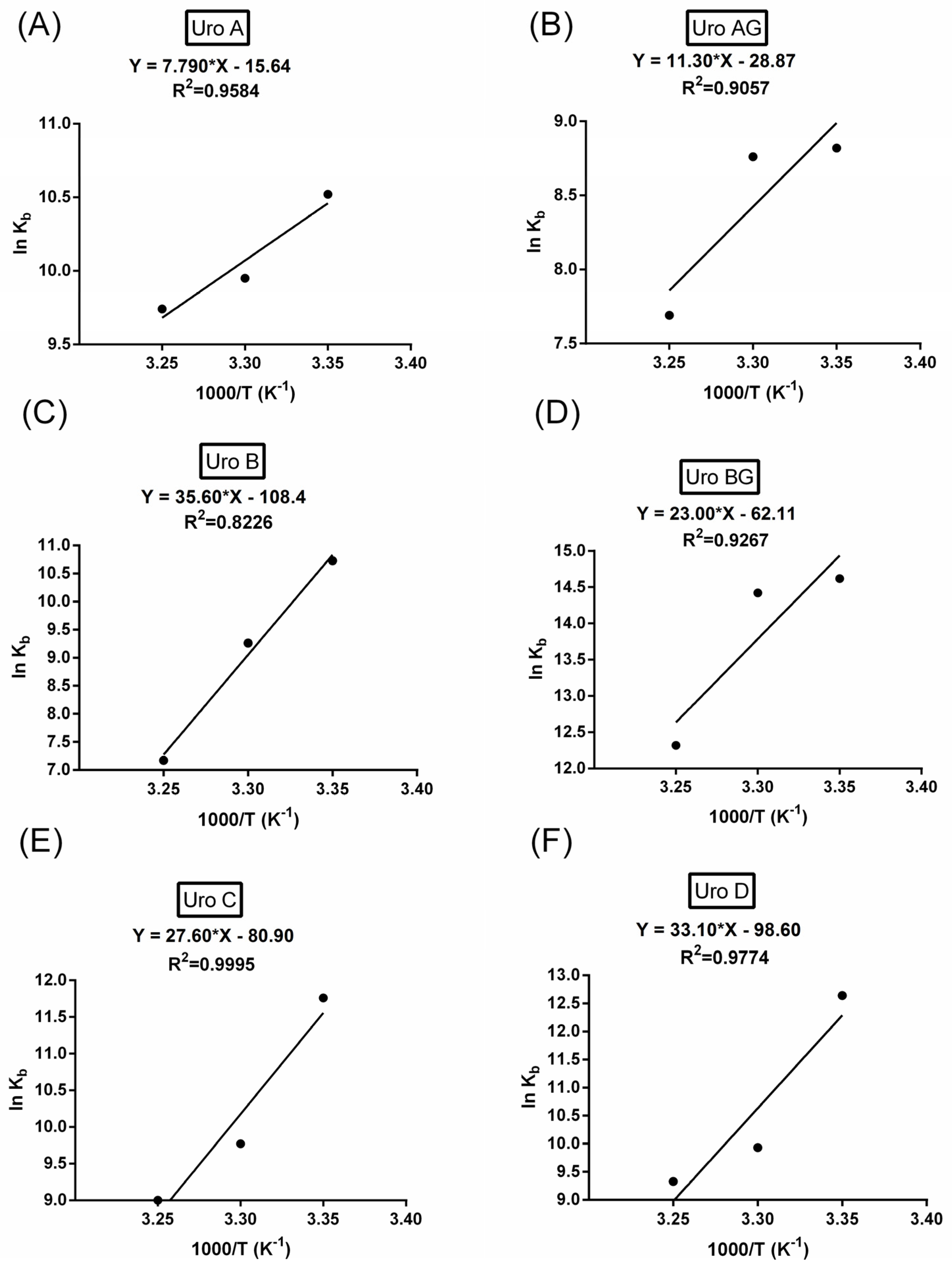
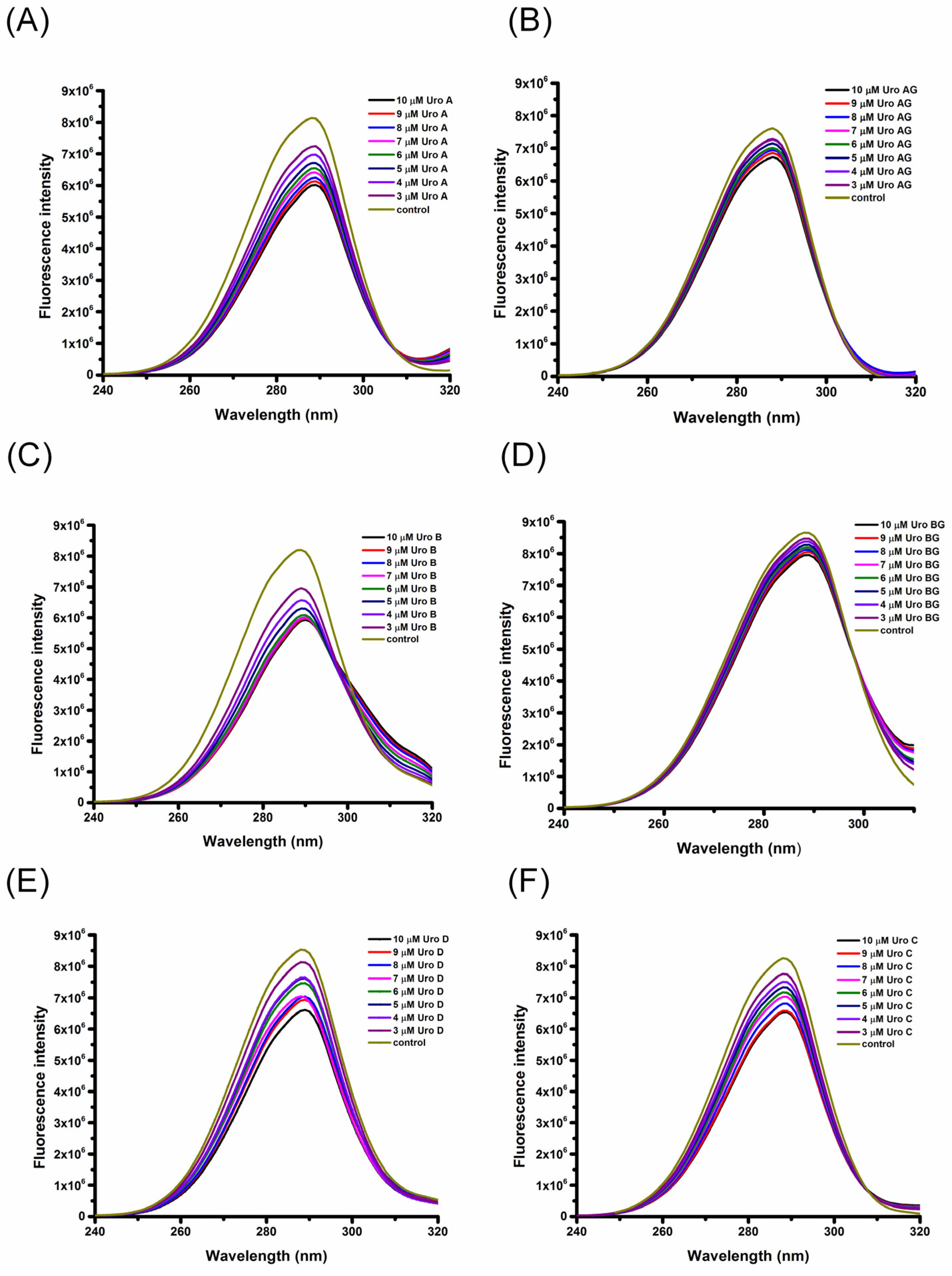

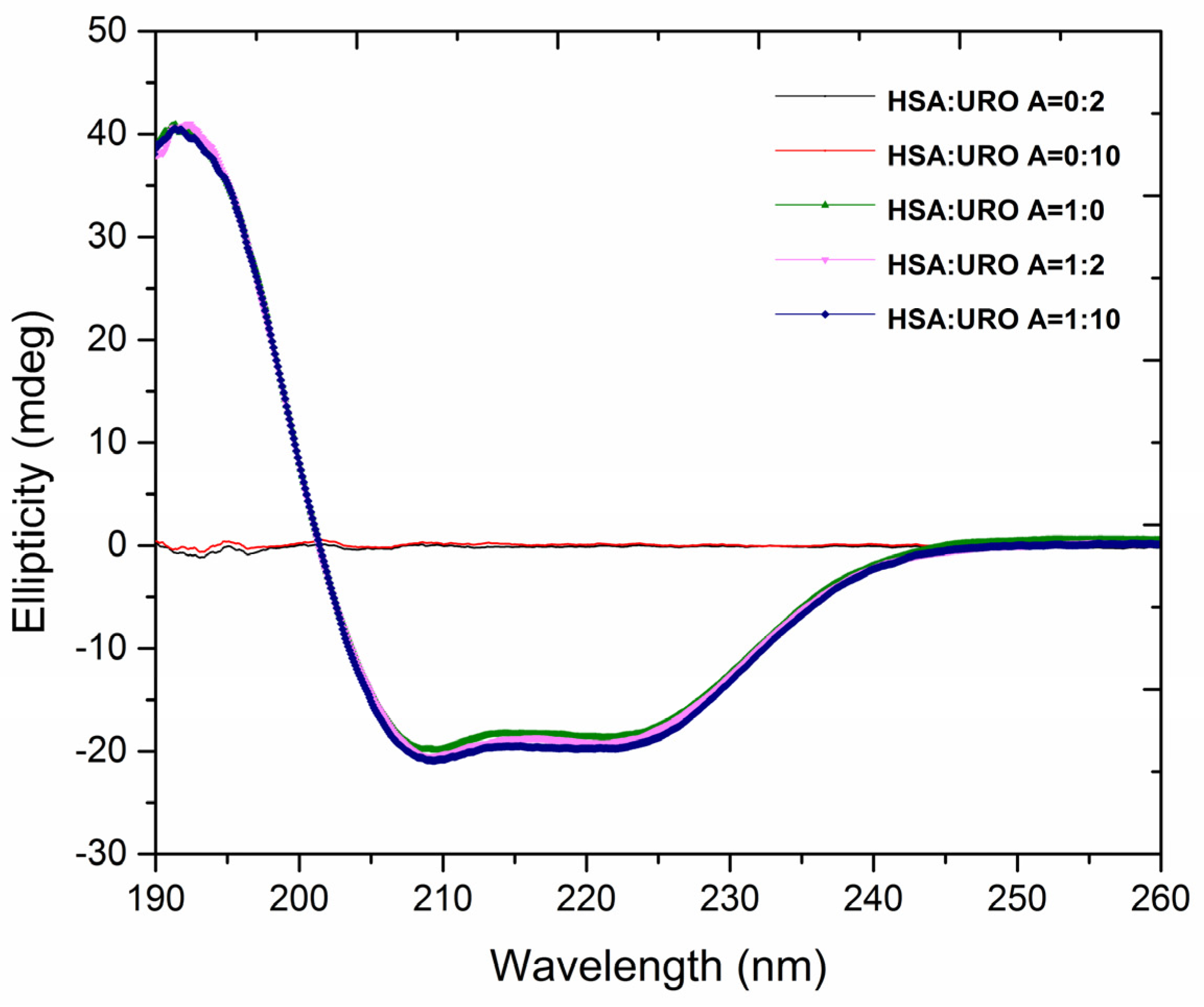
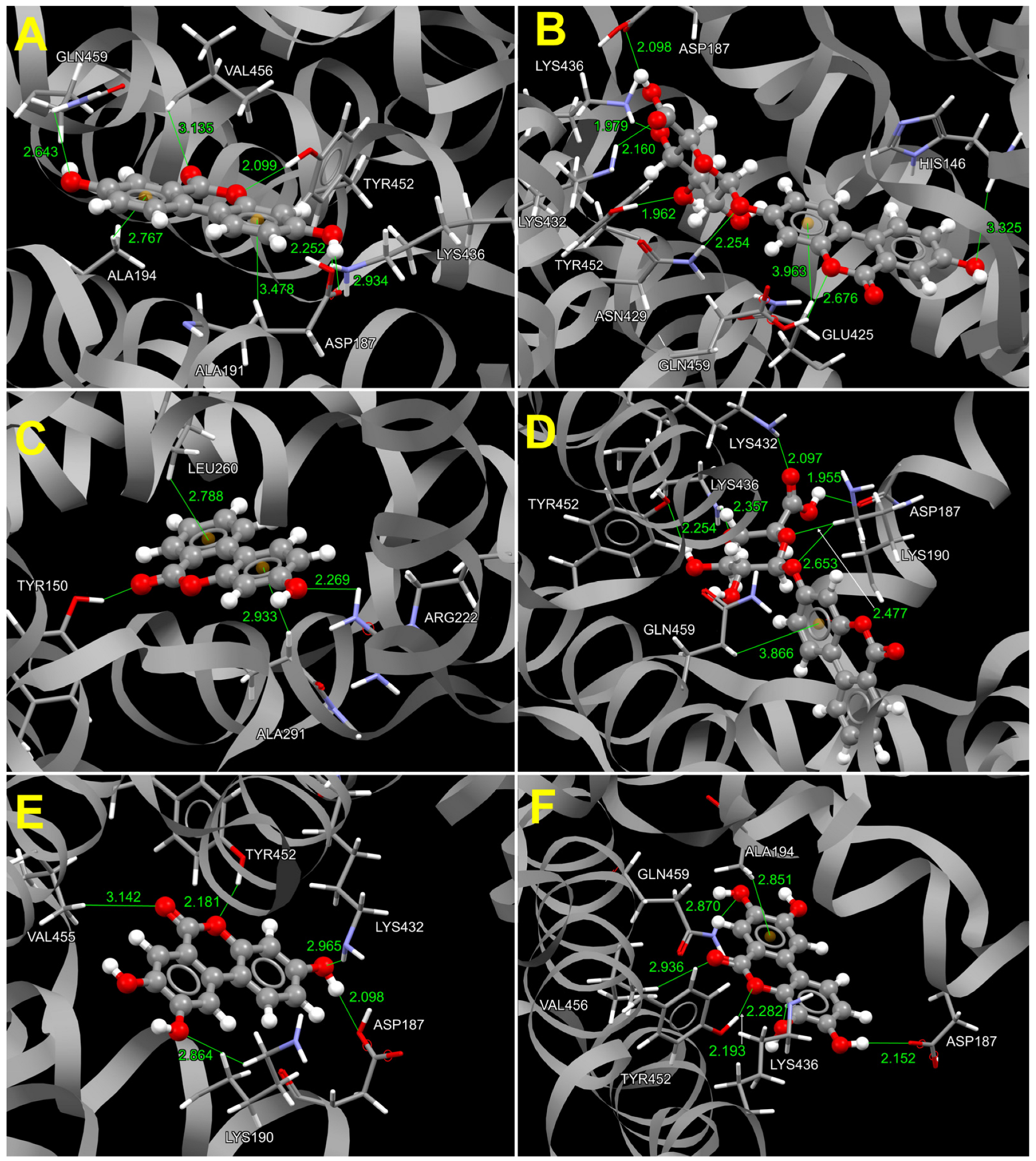

| Urolithin | pH | T (K) | Ksv (Lmol−1) × 104 | Kq (Lmol−1s−1) × 1012 | aR2 | S.D. | Kb (Lmol−1) × 104 | n | bR2 |
|---|---|---|---|---|---|---|---|---|---|
| URO A | 7.4 | 298 | 3.52 | 3.52 | 0.9959 | 0.0928 | 3.71 | 0.975 | 0.9927 |
| 303 | 3.54 | 3.54 | 0.9767 | 0.2214 | 2.1 | 0.925 | 0.9608 | ||
| 310 | 3.92 | 3.92 | 0.9878 | 0.1778 | 1.7 | 0.893 | 0.9817 | ||
| URO AG | 7.4 | 298 | 2.75 | 2.75 | 0.9883 | 0.1222 | 0.68 | 0.848 | 0.98 |
| 303 | 2.73 | 2.73 | 0.9835 | 0.1442 | 0.64 | 0.842 | 0.9714 | ||
| 310 | 2.64 | 2.64 | 0.9696 | 0.1997 | 0.22 | 0.758 | 0.9119 | ||
| URO B | 7.4 | 298 | 4.5 | 4.5 | 0.9922 | 0.163 | 4.59 | 0.961 | 0.993 |
| 303 | 4.78 | 4.78 | 0.983 | 0.2564 | 1.05 | 1.026 | 0.9892 | ||
| 310 | 4.83 | 4.83 | 0.9913 | 0.1543 | 0.13 | 0.774 | 0.9848 | ||
| URO BG | 7.4 | 298 | 7.24 | 7.24 | 0.9942 | 0.2708 | 222.84 | 1.253 | 0.9952 |
| 303 | 6.74 | 6.74 | 0.9985 | 0.1181 | 183.23 | 1.286 | 0.9972 | ||
| 310 | 6.67 | 6.67 | 0.9791 | 0.3103 | 22.49 | 1.064 | 0.952 | ||
| URO C | 7.4 | 298 | 3.62 | 3.62 | 0.9896 | 0.1547 | 12.85 | 1.085 | 0.9819 |
| 303 | 3.69 | 3.69 | 0.9886 | 0.1514 | 1.76 | 0.907 | 0.9784 | ||
| 310 | 4.59 | 4.59 | 0.9798 | 0.2692 | 0.81 | 0.794 | 0.988 | ||
| URO D | 7.4 | 298 | 3.69 | 3.69 | 0.9967 | 0.092 | 30.9 | 1.158 | 0.9947 |
| 303 | 4.11 | 4.11 | 0.9827 | 0.2231 | 2.06 | 0.886 | 0.9892 | ||
| 310 | 4.5 | 4.5 | 0.9854 | 0.2236 | 1.13 | 0.884 | 0.9876 |
| Urolithin | pH | T (K) | ΔH (kJ mol−1) | ΔS (J mol−1K−1) | ΔG (kJ mol−1) | R2 |
|---|---|---|---|---|---|---|
| URO A | 7.4 | 298 | −64.77 | −130.03 | −26.03 | 0.9584 |
| 303 | −25.38 | |||||
| 310 | −24.47 | |||||
| URO AG | 7.4 | 298 | −93.95 | −240.02 | −22.42 | 0.9057 |
| 303 | −21.22 | |||||
| 310 | −19.54 | |||||
| URO B | 7.4 | 298 | −295.98 | −901.24 | −27.41 | 0.8226 |
| 303 | −22.98 | |||||
| 310 | −16.59 | |||||
| URO BG | 7.4 | 298 | −191.22 | −516.38 | −37.34 | 0.9267 |
| 303 | −34.76 | |||||
| 310 | −31.14 | |||||
| URO C | 7.4 | 298 | −229.47 | −672.6 | −29.03 | 0.9995 |
| 303 | −25.67 | |||||
| 310 | −20.96 | |||||
| URO D | 7.4 | 298 | −275.19 | −819.76 | −30.9 | 0.9774 |
| 303 | −26.8 | |||||
| 310 | −21.06 |
| Binding Site | Etot (kcal mol−1) | |||||
|---|---|---|---|---|---|---|
| URO A | URO AG | URO B | URO BG | URO C | URO D | |
| Sudlow site I | −11.50 | −13.59 | −11.97 | −13.35 | −11.57 | −11.38 |
| FA9/Cleft | −11.53 | −16.03 | −11.86 | −15.02 | −13.14 | −12.29 |
| Ligand efficiencies (kcal mol−1Heavy Atom−1) | ||||||
| Sudlow site I | −0.68 | −0.68 | −0.70 | −0.64 | −0.64 | −0.60 |
| FA9/Cleft | −0.68 | −0.80 | −0.70 | −0.72 | −0.73 | −0.65 |
| Binding Site | URO A | URO AG | URO B | URO BG | URO C | URO D | |
|---|---|---|---|---|---|---|---|
| FA-HSA | |||||||
| FA8 | Etot | −14.49 | −17.29 | −14.14 | −18.61 | −14.34 | −14.29 |
| LE | −0.85 | −0.86 | −0.83 | −0.89 | −0.80 | −0.75 | |
| FA9/Cleft | Etot | −14.58 | −19.08 | −13.99 | −19.29 | −14.47 | −15.03 |
| LE | −0.86 | −0.95 | −0.82 | −0.92 | −0.80 | −0.79 | |
| Hem-HSA | |||||||
| FA8 | Etot | −12.92 | −16.87 | −13.40 | −15.91 | −13.46 | −12.89 |
| LE | −0.76 | −0.84 | −0.79 | −0.76 | −0.75 | −0.68 | |
| FA9/Cleft | Etot | −11.23 | −16.99 | −10.96 | −16.24 | −11.65 | −11.84 |
| LE | −0.66 | −0.85 | −0.64 | −0.77 | −0.65 | −0.62 | |
Disclaimer/Publisher’s Note: The statements, opinions and data contained in all publications are solely those of the individual author(s) and contributor(s) and not of MDPI and/or the editor(s). MDPI and/or the editor(s) disclaim responsibility for any injury to people or property resulting from any ideas, methods, instructions or products referred to in the content. |
© 2024 by the authors. Licensee MDPI, Basel, Switzerland. This article is an open access article distributed under the terms and conditions of the Creative Commons Attribution (CC BY) license (https://creativecommons.org/licenses/by/4.0/).
Share and Cite
Zelenović, N.; Ristić, P.; Polović, N.; Todorović, T.; Kojadinović, M.; Popović, M. A Multi-Spectroscopic and Molecular Docking Analysis of the Biophysical Interaction between Food Polyphenols, Urolithins, and Human Serum Albumin. Molecules 2024, 29, 4474. https://doi.org/10.3390/molecules29184474
Zelenović N, Ristić P, Polović N, Todorović T, Kojadinović M, Popović M. A Multi-Spectroscopic and Molecular Docking Analysis of the Biophysical Interaction between Food Polyphenols, Urolithins, and Human Serum Albumin. Molecules. 2024; 29(18):4474. https://doi.org/10.3390/molecules29184474
Chicago/Turabian StyleZelenović, Nevena, Predrag Ristić, Natalija Polović, Tamara Todorović, Milica Kojadinović, and Milica Popović. 2024. "A Multi-Spectroscopic and Molecular Docking Analysis of the Biophysical Interaction between Food Polyphenols, Urolithins, and Human Serum Albumin" Molecules 29, no. 18: 4474. https://doi.org/10.3390/molecules29184474






